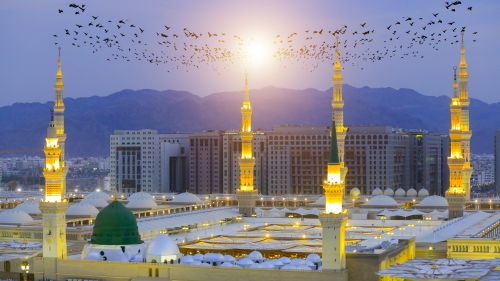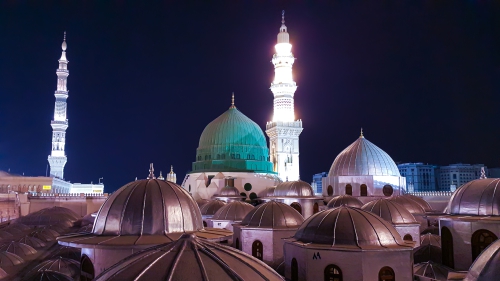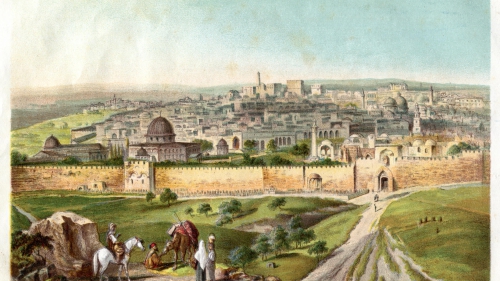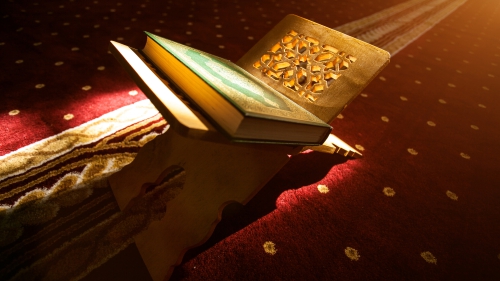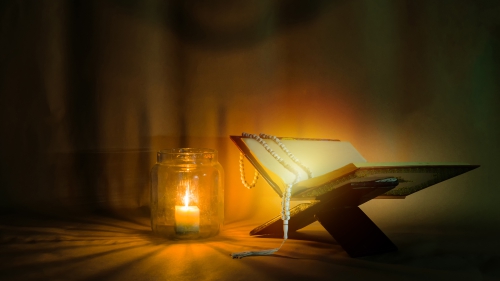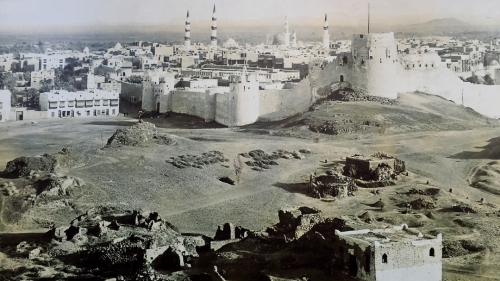The Houses of the Prophet
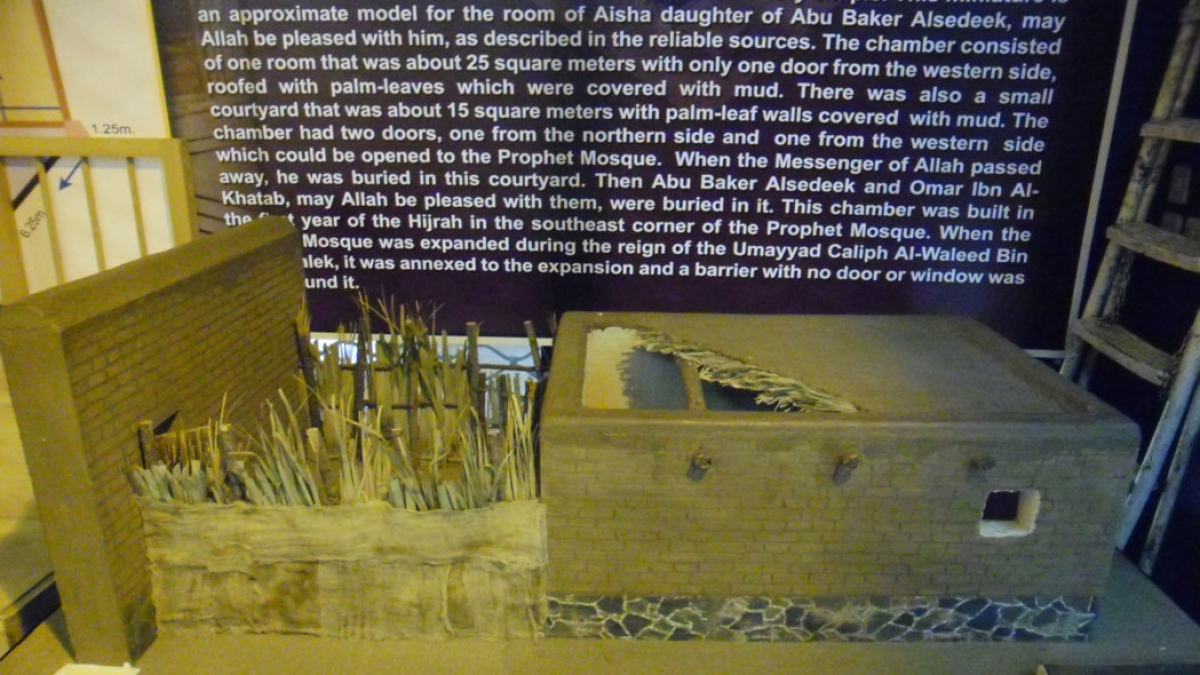
Introduction: the houses in Madinah
Not all houses in Madinah, during the Prophet's time, were same. By and large, most houses were characterized by several notable features, the most important one of which perhaps was their moderate spaciousness. As we are absolutely sure that loftiness was not their trademark, we are likewise in no doubt that spaciousness, as much as needed and in line with the standards of the day, was their underlying quality.
Our argument is based first and foremost on the Prophet's saying to the effect that of man's happiness are a good wife, a spacious residence, a good neighbour, and a good mount.
The Prophet (sa) himself prayed to Allah (st) to forgive him, make his house more spacious and bless his sustenance.
Once Khalid ibn Walid complained to the Prophet (sa) that his house was too small to accommodate his family. At this, the Prophet (sa) asked him to build more rooms on the roof of the existing house and to ask Allah for abundance.
That the houses of Madinah have been sufficiently spacious and some of them even lofty and exalted can be corroborated by the fact that the Prophet (sa) stayed in the house of Abu Ayyub al-Ansari (ra) in the wake of the migration before his houses were constructed. The Prophet's houses and all the migrants' houses were not constructed until after the construction of the Prophet's mosque. It was near the courtyard of the house of Abu Ayyub al-Ansari that the Prophet (sa) alighted from his camel on arrival from Makkah. Initially, he stayed downstairs, which made Abu Ayyub and his wife, who stayed upstairs, very uncomfortable, in that they could not accept walking above the head of the Prophet (sa). Shortly, though, they moved downstairs and the Prophet (sa) upstairs.
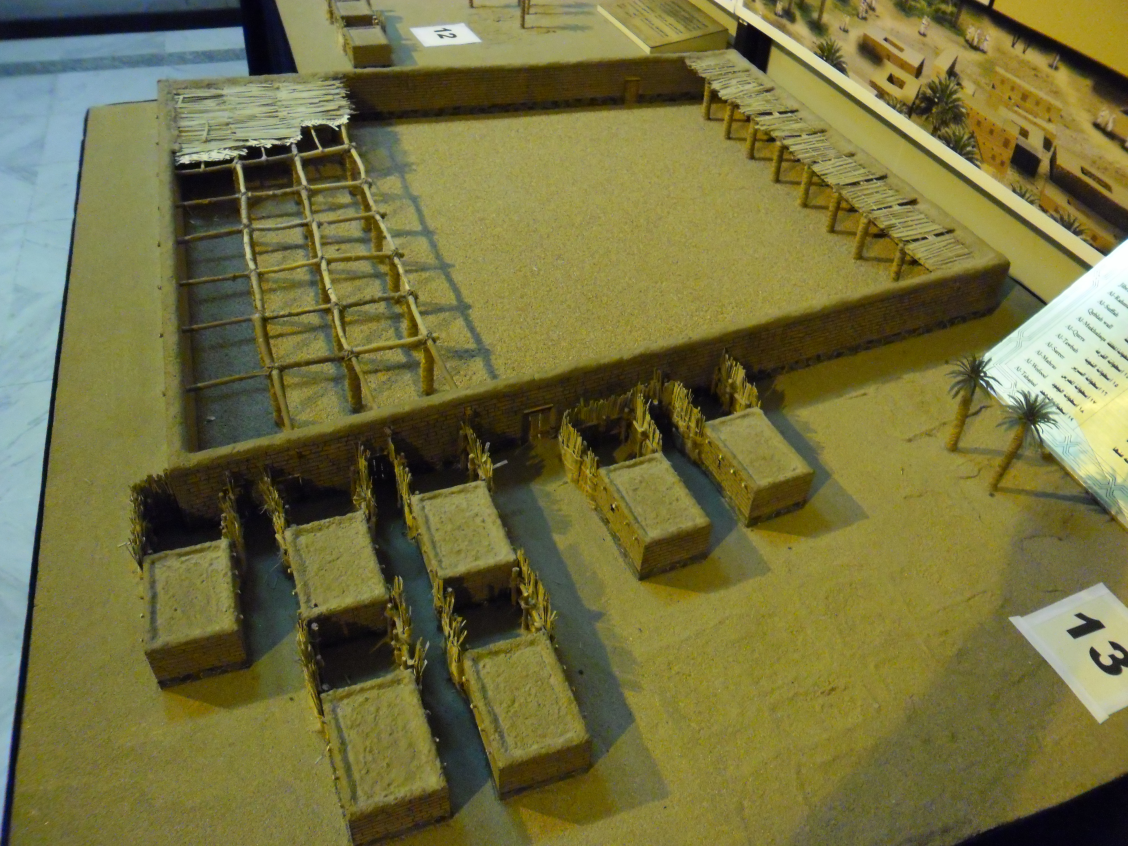
It should be borne in mind that in terms of housing, most of the migrants in the beginning shared the same fate, they stayed with the helpers (Ansar), hence the Prophet's encouragement after the mosque had been completed that houses be constructed and the people help each other in the matter.
Also, since the Prophet's mosque did not have a minaret, a Companion, Bilal, used to climb to the roof of the house of a woman from Banu an-Najjar clan to call for the morning prayer because it was the highest and loftiest of all the houses around the mosque.
So big and spacious were some houses with their courtyards that the Prophet (sa) used to accommodate some of his guests or visiting delegations in them. The house of Ramlah bint al-Harith an-Najjariyah (rah), which reportedly had date-palms in its courtyard, once served as an interim detention centre.
The house of 'Abdur-Rahman ibn 'Awf, the first that was constructed by a migrant in Madinah, served as a guesthouse too. It was termed as Dar al-Kubra (the largest house) as well as Dar al-Difan (guest-house). The Prophet (sa) is said to have taken part in its construction.
'Abdur-Rahman ibn 'Awf was one of the wealthiest Companions of the Prophet (sa) also known as Khuzzan Allah (Allah's treasurers) on account of earning their wealth lawfully and consuming the same lavishly not for their own interests but for the interests of the community and its growing needs.
In the stable(s) of the house of 'Urwah ibn Abi al-Ja'd, some people could see as many as seventy horses. The Companion 'Urwah ibn Abi al-Ja'd was the one for whom the Prophet (sa) once invoked Allah to bless him in his business dealings.
Production and trade activities were also carried out in some dwellings of Madinah. An example is the house of the Prophet's son Ibrahim's foster-family, Umm Sayf, the foster-mother, and Abu Sayf, the foster-father who was a blacksmith. The house of Abu Sayf was in one of the suburbs of Madinah.
One day the Prophet (sa) went to see Ibrahim. He was accompanied by his servant Anas ibn Malik. When they reached the house, they found Abu Sayf blowing fire with the help of the blacksmith's bellows and the house was filled with smoke.
According to Hilal ibn Yasaf, he and some people used to sell clothes in the house of Suwayd ibn Muqarrin (ra).

The Prophet's houses
However, the Prophet (sa) and his household remained indifferent to the prospects of erecting and possessing more than that which was extremely rudimentary and really necessary. Such was the case throughout his life, even after the economic situation of the Muslims had notably improved. Some of the most often referred to furnishing elements in the Prophet's houses were: a bed, a mat, a blanket, and curtains of black-hair cloth.
The Prophet's austere living was such that when once 'Umar ibn al-Khattab paid a visit to him, he was moved to tears. The Prophet (sa) asked: al-Khattab, what makes you weep?
'Umar answered: Messenger of Allah, why should I not shed tears? This mat [which 'Umar found the Prophet (sa) lying on] has left its marks on your sides and I do not see in your store room [except these few things] that I have seen. Persian and Byzantine sovereigns are leading their lives in plenty whereas you are Allah's Messenger, His chosen one, and yet that is your store!
The Prophet (sa) said: Ibn Khattab, aren't you satisfied that for us is the prosperity of the hereafter and for them the prosperity of this world?
Nevertheless, many of the houses of the Prophet (sa) were far bigger and roomy than what appears to many people who erroneously perceive them as small huts or no more than mere tiny rooms rather than adequate houses, for most of such houses must have had, at least and in accordance with the standards and norms of the day, a bathroom, a kitchen, a sleeping room, a room (place) for visitors, and a storage. All these are necessities indeed not only desirable for normal and decent living but also necessitated by some religious tenets, such as privacy protection, neatness and cleanliness. When 'Umar ibn al-Khattab visited the Prophet (sa), as in the aforementioned hadith, though he was moved to tears by the simplicity of the Prophet's living, yet he reported that he found the Prophet (sa) in one of his houses in his attic to which one must climb by means of a ladder made of date-palm. At the end of the ladder the Prophet's servant, Rabah, through whom 'Umar (ra) had obtained beforehand the Prophet's permission to enter, was sitting. After the visit 'Umar climbed down with the Prophet (sa). While 'Umar had to do so catching hold of the wood of the palm-tree, the Prophet (sa) did the same with such ease that it seemed as though he was walking on the ground; he needed not hold anything for support.
If truth be told, had the Prophet's houses been as small and as inconvenient as alleged by some people, his life and that of his household would have been seriously disturbed and interrupted, as there were always those coming to him for various purposes such as to serve him, visit him and his family, learn from him, ask questions, seek counsel from him, etcetera. It would have been especially so during the early years when scores of hospitality manners, plus general rules of cultured social ethics, were yet to be consolidated in the hearts and minds of many individuals. In reality, every period of the Prophet's mission was pretty much susceptible to this kind of discomfort for him, sometimes more and sometimes less, because scores of people from different places in the Arabian Peninsula never ceased to throng Madinah (the trend actually kept intensifying as time went by) accepting Islam and offering their allegiance to the Prophet (sa). Before the doors of the migration were closed after the conquest of Makkah, some people habitually sought to settle themselves in Madinah having embraced Islam and pledged their allegiance, whereas others, after spending some time as the Prophet's guests and the guests of the state, returned to their respective tribes and communities henceforth maintaining strong relationship with the centre.
When the Prophet (sa) married Zaynab bint Jahsh, he asked Anas ibn Malik, the Prophet's servant for ten years, to invite whomever he could meet for a meal which Anas' mother had prepared beforehand and sent to the Prophet (sa) as a gift. Anas did as directed and a crowd of about three hundred men soon congregated in the mosque. The Prophet (sa) invited them in batches of ten to come in and eat. In no way could the given food satisfy the number of people mentioned. However, the Prophet (sa) had earlier supplicated to Allah for abundance and they all ate their fill and were contented. This was yet another miracle of the Prophet Muhammad (sa). Having enjoyed their meal, all the guests returned except a few who remained in the house conversing. The Prophet (sa) was unhappy about this but remained silent. He went out to the dwellings of his other wives staying there until everyone was gone, whereupon he returned.
As a lesson to people for their future conduct with the Prophet (sa) and his household, the following verse from the Qur'an was revealed:
{O you, who have believed, do not enter the houses of the Prophet except when you are permitted for a meal, without awaiting its readiness. But when you are invited, then enter; and when you have eaten, disperse without seeking to remain for conversation. Indeed, that [behaviour] was troubling the Prophet, and he is shy of [dismissing] you. But Allah is not shy of the truth. And when you ask [his wives] for something, ask them from behind a partition. That is purer for your hearts and their hearts. And it is not [conceivable or lawful] for you to harm the Messenger of Allah or to marry his wives after him, ever. Indeed, that would be in the sight of Allah an enormity.} (Qur'an 33: 53)
Since the peaceful and uninterrupted family life of the Prophet (sa) was at stake, instituting and then firming up the rules of refined social ethics with regard to visiting and talking to the Prophet (sa) was so pertinent, and thus so painstakingly handled, that Allah's revelations had to intervene sporadically. In order to protect the Prophet (sa) and his family from any untoward psychological disturbance or annoyance, Allah, the Exalted, mentions:
{Indeed, those who call you, [O Muhammad], from behind the chambers - most of them do not use reason. And if they had been patient until you [could] come out to them, it would have been better for them. But Allah is Forgiving and Merciful.} (Qur'an 49: 4-5)
It has also been mentioned in the Qur'an:
{O you who have believed, do not raise your voices above the voice of the Prophet or be loud to him in speech like the loudness of some of you to others, lest your deeds become worthless while you perceive not.} (Qur'an 49: 2)
It should be observed that Chapter 49 of the Qur'an was revealed in the ninth year, the Year of Deputations, when a large number of deputations of all kinds thronged to Madinah to meet the Prophet (sa) and offer their allegiance to Islam. Due to the frequency of such meetings, as well as the number of delegations and delegates, the Prophet (sa) used to meet the people right in front of his houses, inside the mosque. The pillar which stands today at the said location is thus called "the Pillar of Deputations" (Ustuwan al-Wufud).
Scholars unanimously agree that so essential in the life of a Muslim are the said moral principles pertaining to guaranteeing privacy and peacefulness to the Prophet's life that conforming to them was binding not only when the Prophet (sa) was alive but also in every subsequent era whenever one paid a visit to his grave.
A partial description of the Prophet's houses is given by Ibn Sa'd in his at-Tabaqat al-Kubra. A narrator named 'Abdullah ibn Yazid saw them just before they were knocked down by the order of the Caliph al-Walid ibn 'Abd al-Malik from Syria in the year 88/707 because he wanted to enlarge the Prophet's mosque.
There were four houses of mud brick, with apartments partitioned off by palm branches plastered with mud, and five houses made of palm branches plastered with mud and not divided into rooms. Over the doors were curtains of black hair-cloth. Each curtain measured 3 by 3 cubits. One could touch the roof with the hand.
Several other eyewitnesses have given similar accounts on the matter, which are recorded elsewhere. It looks as if the Prophet's house in which his wife Maymunah (rah) resided was not partitioned into rooms.
'Abdullah ibn 'Abbas once slept as a youngster there as Maymunah was his aunt, when the Prophet's turn was to sleep in Maymunah's apartment. So detailed and accurate was Ibn 'Abbas' account on how the Prophet (sa) had spent his night in worship that it seems they all must have slept in one big room which was not partitioned.
By the time the framework of the Prophet's houses was witnessed by different narrators and chroniclers on whose narratives our understanding of the subject depends, the same must have been considerably impinged on by the time factor since the houses had been erected using ephemeral materials. Nevertheless, the accounts given above may still help in perceiving the original state of the Prophet's houses, which served as a standard for houses in Madinah built during the same period, particularly in terms of building materials, plan and function.
The disposition of many Muslims in Madinah towards the notion of the house and building in general is well epitomized by the experience of Salman al-Farisi (ra), a celebrated Companion of the Prophet (sa), who once summoned a mason to build a house for him. Salman asked the man how he was going to do the job. Knowing the extent of piety, devotion and simplicity of Salman, the mason replied: "It is a house for you to protect yourself against the heat of the sun and dwell in the cold weather. When you stand erect in it, it touches your head."
In his book History of Madinah Munawwarah, Muhammad Ilyas asserts that each of the Prophet's houses had a residential part as well as a tiny backyard:
"The backyard was enclosed by the branches of palm trees and unbaked bricks. Blankets of hair were thrown on them to ensure privacy in the yard. The door of each hujrah [apartment] was not built from an expensive wood. Each door had a rough blanket hanging there for privacy. Hence each hujrah reflected humbleness and modesty. The dimension of each hujrah was approximately 5 meters by 4 meters and the backyard was 5 meters by 3 meters. A person standing in the huujrah could touch the ceiling with his hand. Hasan Basri said: I had not yet come of age and I used to visit the hujrah. I could touch the ceiling with my hand when I was standing in the hujrah.
The location of the Prophet's houses
It is a common belief that against the outer side of the eastern wall of the Prophet's mosque, the houses for the Prophet (sa) and his household were built. The doors of the houses on their western wall opened into the mosque.
In total, there were nine houses. At first, only two houses were erected as the Prophet (sa) was yet to marry all his wives. The first two houses were for his then only two wives: 'A'ishah and Sawdah. As he married his other wives, the new houses were gradually built. However, some accounts suggest that the Prophet's houses were concentrated not only on the eastern side of the mosque, but were rather located either on all sides, save the western one, or on the eastern as well as the northern side only.
Such might have been the arrangement of the Prophet's houses, the sizes of which varied yet all were as spacious as needed for living a decent and convenient family life, that they did not necessarily form a regular row against the mosque's eastern wall and were not uniform in appearance. Some of them might have been attached to the mosque, while others stood apart. The possibility that one house stood between the mosque and another house, that is to say the latter did not stand directly next to the mosque, could not be utterly precluded either, more so if we accept that all the nine houses were positioned on the mosque's eastern side only, which was for about the first seven years of the mosque's existence when it was just about 30 to 35 meters long, and then after the first mosque extension about 50 meters long.
In other words, to imagine nine houses aligned with the mosque's wall, which was only 50 meters, at most, not counting some passageways between the houses, as well as an entrance with a kind of pavement big enough that some beasts could be fastened, and death penalty by stoning could be carried out on it, is quite difficult and even impossible.
Another proposition that appears quite realistic is that the Prophet's houses were situated on more than just one side of the mosque. This view is supported by the fact that they were in a row, but having needed more space than what the size of the mosque which they abutted was offering, about four or five houses extended beyond the northern boundary of the mosque.
Ibn Hajar al-'Asqalani even stated, on the authority of Ibn Batal and Ibn Habib, that Musalla al-Jana'iz (a vast plain area designated for offering funeral prayers) bordered the mosque on its eastern side where the Prophet's nine houses are supposed to have existed.
The word lasiq (literally adhesive, agglutinative and sticking) used by Ibn Hajar to indicate the position of Musalla al-Jana'iz vis--vis the mosque signify nothing but that the two stood next to each other with nothing standing between them. Without a doubt, this account further adds to the complexity that surrounds the contention that all the houses of the Prophet (sa) adjoined the eastern side of the Prophet's mosque only.
This article is an excerpt from the author's book: "The Origins and Functions of Islamic Domestic Courtyards"
*****
Dr. Spahic Omer, a Bosnian currently residing in Malaysia, is an Associate Professor at the Kulliyyah of Architecture and Environmental Design, International Islamic University Malaysia. He studied in Bosnia, Egypt and Malaysia. His research interests cover Islamic history, culture and civilization, as well as the history and philosophy of the Islamic built environment. He can be reached at spahicoyahoo.com; his blog is at www.medinanet.org .
Topics: History, Madinah (Medina), Masjid Al Nabawi, Prophet Muhammad (S)
Views: 55086
Related Suggestions







